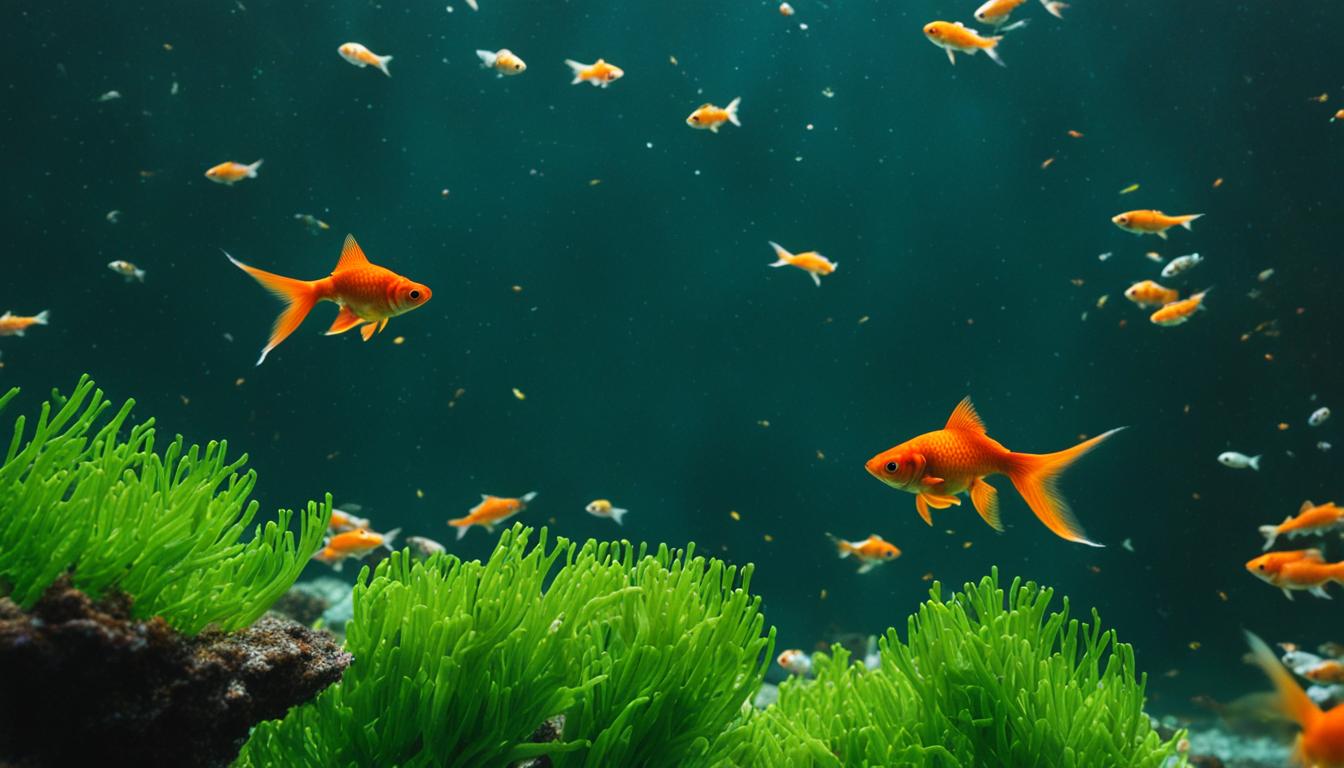Last Updated on 2 months by admin
Goldfish are fascinating creatures that have captivated the imagination of aquarium enthusiasts for centuries. With their vibrant colors and graceful swimming, they are often a popular choice for beginner and experienced fishkeepers alike. However, there are many myths and misconceptions surrounding the feeding behavior and compatibility of goldfish with other fish.
One common question that arises is, “Do goldfish eat other fish?” While goldfish are generally not aggressive or predatory towards other fish, there are some instances where they may exhibit such behavior. For instance, when goldfish are hungry and left without food, they may resort to eating bite-sized fish or even their own babies to survive. It is important to note that once the baby fish grow and become larger, the risk of predation decreases significantly.
In addition, goldfish may accidentally consume smaller fish or snails in the same tank while searching for food. These incidents are more often a result of mistaken identity rather than intentional predation. When considering tank mates for goldfish, it is crucial to take into account the size and compatibility of other fish and invertebrates to prevent any incidents.
Key Takeaways:
- Goldfish are generally not aggressive towards other fish, but they may eat smaller fish or their own babies when hungry.
- Goldfish may accidentally consume smaller fish or snails in the same tank while searching for food.
- When keeping goldfish with other fish, it is important to consider the size and compatibility of the tank mates.
- Proper care, nutrition, and water quality are essential for the health and longevity of goldfish.
Do Goldfish Eat Other Goldfish?
Goldfish are known for their peaceful nature, but under certain circumstances, they may exhibit cannibalistic behavior. This can lead to the unsettling sight of goldfish eating their own babies or even consuming other goldfish in the tank.
When goldfish are hungry and food is scarce, they may mistake their own offspring for edible prey. Goldfish do not possess strong paternal instincts and may view their offspring as a potential food source. Additionally, baby goldfish are often smaller and more vulnerable, making them easy targets for larger goldfish or other predators in the tank.
As the baby fish grow and become more independent, the risk of predation decreases. They develop the ability to swim faster and evade their predators more effectively. However, it is important to note that the exact behavior of goldfish can vary depending on individual temperament and other environmental factors.
In order to minimize the chances of cannibalism among goldfish, it is important to provide a well-balanced diet and ensure that they are being fed regularly. Hungry goldfish are more likely to resort to eating their own offspring or other tank mates. Additionally, providing ample hiding spots and vegetation in the tank can help protect the baby goldfish from being targeted.
“Goldfish may eat their own babies when hunger strikes, but with proper care and feeding, the risk of cannibalism can be greatly reduced.”
It is worth noting that cannibalism is not limited to goldfish alone and can be observed in other species as well. In the natural world, cannibalism can serve as a survival mechanism when food is scarce. In a captive environment, however, it is crucial for goldfish enthusiasts to provide adequate nourishment and create a suitable habitat to discourage such behaviors.
The Importance of Feeding Routine and Tank Stability
Establishing a consistent feeding routine is key to preventing goldfish from becoming overly hungry and resorting to cannibalism. Feeding them a varied diet that includes high-quality pellets, flakes, and fresh vegetables can help keep their appetites satisfied.
In addition to feeding, maintaining tank stability is crucial in preventing stress among goldfish, which can contribute to aggressive behavior and cannibalism. Ensure that the tank is appropriately sized for the number of goldfish and provide ample space for them to swim and establish their territories.
A well-maintained tank with clean and properly filtered water is also essential for the overall health and well-being of goldfish. Regular water changes and monitoring water parameters such as pH, ammonia, nitrite, and nitrate levels can help create a stable and stress-free environment for your goldfish.
By creating a well-balanced and nurturing environment for your goldfish, you can help reduce the likelihood of cannibalistic behavior and ensure the well-being of all the fish in your tank.
| Cause | Risk of Cannibalism |
|---|---|
| Insufficient feeding | High |
| Oversized tank mates | Medium |
| Inadequate hiding spots | Medium |
| Poor water quality | Medium |
| Stress from overcrowding | Medium |
| Lack of vegetation | Low |
Why Do Goldfish Eat Other Fish?
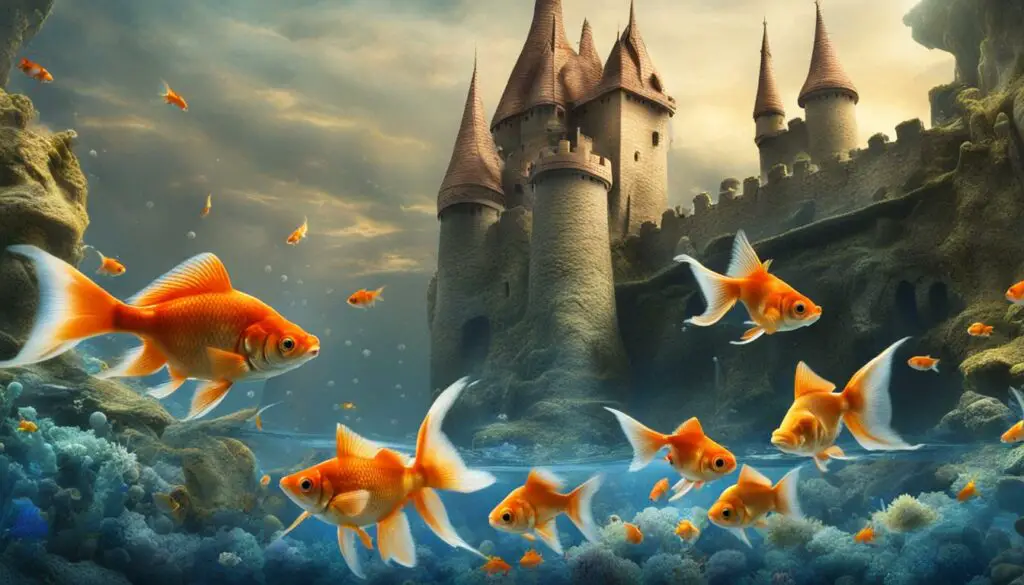
Goldfish are typically peaceful creatures, but under certain circumstances, they may exhibit aggressive behavior towards other fish in their tank. This can lead to them attacking or even consuming larger fish. Understanding the reasons behind this behavior can help fishkeepers create a harmonious and balanced environment for their goldfish.
One of the primary factors that can trigger goldfish to eat other fish is territoriality. Goldfish are known to mark their territory, and when they feel that their space is being invaded or overcrowded, they may become aggressive towards other fish. In an effort to protect their territory, goldfish may attack or consume larger fish that they perceive as a threat.
Overcrowding is a common cause of territorial behavior in goldfish. When the tank is too small or has too many fish, goldfish can become stressed and agitated. This can intensify their territorial instincts, leading to increased aggression. Providing ample space and avoiding overcrowding is essential to prevent goldfish from turning to larger fish as a means of marking their territory.
Goldfish Aggression and Territory Marking: A Delicate Balance
It is important to note that not all goldfish will exhibit aggressive behavior towards other fish, and there is considerable variation in individual temperament. Some goldfish may remain peaceful even in crowded conditions, while others may display a higher degree of aggressiveness.
When introducing new fish to a tank with goldfish, it is crucial to observe their behavior closely. Incompatible tankmates, such as species that are smaller or more docile, may be at risk of becoming targets of goldfish aggression. By carefully selecting compatible fish that can coexist peacefully with goldfish, fishkeepers can create a harmonious community tank.
“When goldfish feel their territory is being invaded, they may become aggressive and territorial, leading them to attack or eat larger fish.”
Preventing Goldfish from Eating Larger Fish
To prevent goldfish from eating larger fish, it is essential to take several proactive steps. Here are some key strategies:
- Provide Sufficient Space: Ensure that your tank provides enough space for each fish to establish their territory. A larger tank will decrease the likelihood of aggressive behavior.
- Select Suitable Tankmates: Choose fish species that are similar in size and temperament to your goldfish. Avoid keeping species that goldfish may perceive as threats.
- Offer Hiding Places: Incorporate rocks, plants, and other decorations in the tank to provide hiding spots for fish seeking refuge from territorial disputes.
- Monitor Fish Behavior: Regularly observe your fish’s behavior to identify any signs of aggression or stress. Address any issues promptly to maintain peace in the tank.
By implementing these measures, goldfish aggression and the consumption of larger fish can be minimized, allowing for a more harmonious and balanced aquarium ecosystem.
Understanding the Complex Behavior of Goldfish
The territorial behavior and occasional consumption of larger fish by goldfish can be influenced by various factors, including the fish’s environment and individual temperament. By gaining a deeper understanding of these behaviors, fishkeepers can create an ideal habitat that promotes the well-being of all fish in the tank.
| Goldfish Behavior | Factors Influencing Behavior | Preventive Measures |
|---|---|---|
| Aggression and territoriality | Overcrowding, invasion of territory | Provide sufficient space, select compatible tankmates, offer hiding places |
| Consumption of larger fish | Perceived threat, hunger | Ensure proper feeding, monitor fish behavior, maintain a balanced ecosystem |
In the next section, we will address another common myth about goldfish: their supposed three-second memory. We will unravel the truth behind this misconception and shed light on the remarkable memory capabilities of these fascinating fish.
Does a Goldfish Eat Dead Fish?

Goldfish, known for their scavenging behavior, may eat dead fish in the tank. When a fish dies, the goldfish may perceive it as a potential food source and consume it as a way to remove the carcass and alleviate their hunger. However, it is crucial to promptly remove any dead fish from the tank to prevent goldfish from consuming them.
Goldfish have a natural inclination to scavenge and will eat anything they come across, including dead fish. This behavior is instinctive and stems from their opportunistic feeding habits. They are attracted to the smell and texture of the decaying fish and may view it as an easy meal.
It is important to maintain a clean and healthy tank environment by regularly monitoring the well-being of fish and promptly removing any deceased individuals. Not only does this prevent goldfish from consuming dead fish, but it also helps maintain water quality and prevent the spread of disease within the tank.
Which Fish Are Safe With a Goldfish?

Goldfish are known for their compatibility with certain species of fish and invertebrates. When it comes to finding suitable tank mates for goldfish, it’s important to consider their compatibility, size, and feeding habits. Here are some fish and invertebrates that can coexist peacefully with goldfish:
Snails
Goldfish generally get along well with snails in the same tank. Snails can help keep the tank clean by consuming algae and leftover food, which benefits both the goldfish and the overall water quality. However, it’s crucial to ensure that the snails are not smaller than the goldfish. Goldfish may accidentally or intentionally consume tiny snails or their eggs.
Other Peaceful Fish
Some peaceful fish species can coexist with goldfish in the same tank. These include:
- Guppies
- Platies
- Mollies
- Tetras
- Danios
- White Cloud Mountain Minnows
When choosing tank mates for goldfish, it’s essential to select fish that have similar care requirements in terms of temperature and water parameters.
Avoid Keeping Shrimp with Goldfish
While goldfish can peacefully coexist with certain fish and snails, it is not recommended to keep shrimp with goldfish. Shrimp are typically small and can easily fit into the goldfish’s mouth, making them vulnerable to becoming a snack. To ensure the safety and well-being of both your goldfish and shrimp, it is best to keep them in separate tanks.
“Introducing compatible tank mates can enhance the overall vitality and beauty of your aquarium while providing a diverse and harmonious aquatic community.”
In conclusion, goldfish can share their tank with various fish and invertebrates, including snails and certain peaceful fish species. However, it’s essential to consider compatibility, size, and feeding habits when selecting tank mates. Additionally, it’s best to avoid keeping shrimp with goldfish due to the risk of predation. By selecting compatible tank mates, you can create a vibrant and harmonious aquatic community in your goldfish tank.
What to Consider When Keeping Goldfish Together
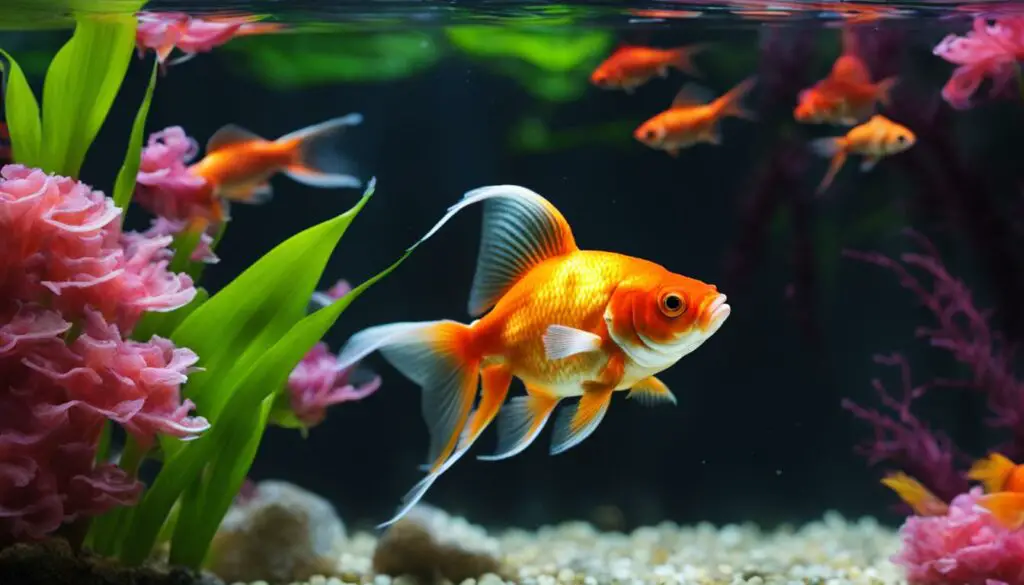
When keeping goldfish together, there are several key considerations to ensure their well-being and a harmonious tank environment. By taking these factors into account, you can create a comfortable and thriving habitat for your goldfish.
Consideration 1: Goldfish Size
It’s crucial to ensure that all the goldfish in the tank are of similar size. This is important to prevent larger fish from preying on smaller ones. Keeping goldfish of similar size minimizes the risk of aggression and promotes a peaceful coexistence.
Consideration 2: Tank Space Requirements
Providing ample space for each goldfish is vital to prevent overcrowding and allow them to swim freely. Goldfish are known for their active and lively nature, so a spacious tank is essential for their well-being. Adequate space also helps maintain good water quality by allowing for efficient filtration and oxygenation.
Consideration 3: Tank Size
A larger tank is recommended for goldfish due to their fast growth and high waste production. As goldfish can grow quite large, providing them with a suitable tank size is crucial to accommodate their size and ensure they have enough room to thrive. A spacious tank also helps reduce stress and promotes healthier fish.
Consideration 4: Providing Hiding Places
Rocks, plants, and other suitable decorations should be included in the tank to provide hiding places and create a safe environment for goldfish. These hiding spots not only offer a sense of security but also help replicate their natural habitats. Creating a visually engaging and stimulating tank setup can contribute to the overall well-being of your goldfish.
By considering these factors when keeping goldfish together, you can promote a harmonious coexistence, reduce the risk of aggression, and provide a comfortable and enriching environment for your beloved aquatic pets.
Myth: Goldfish Have a Three-Second Memory

The myth that goldfish have a three-second memory is widely believed, but it couldn’t be further from the truth. Goldfish actually have a memory span that can last up to five months, giving them the ability to form and retain memories of past events.
Goldfish are highly intelligent creatures and have the capacity to recognize their owners. They can learn routines and associate certain behaviors with specific outcomes. For example, they can be trained to come to the surface of the water to be fed at a particular time each day.
Did You Know? Goldfish can even exhibit excitement when they see their owners, displaying signs of recognition by swimming up to the aquarium glass.
“Goldfish have a memory span that can last up to five months, giving them the ability to form and retain memories of past events.”
This myth about goldfish memory has led to the misconception that goldfish can be kept in small bowls with little care or mental stimulation. In reality, goldfish require proper care, attention, and an appropriate environment to thrive and reach their full potential.
It is important to provide goldfish with a spacious tank that allows them to swim freely and engage in natural behaviors. They also benefit from mental stimulation, such as the inclusion of plants, decorations, and hiding spots in their environment. These elements create a more enriching habitat and help promote the overall well-being of the fish.
To debunk the myth about goldfish memory, it is crucial to understand the true intelligence and capabilities of these fascinating creatures. By providing them with the right conditions, we can ensure that goldfish live happy, healthy lives and continue to surprise us with their impressive memory and behaviors.
Myth: Goldfish Can Be Kept in Bowls
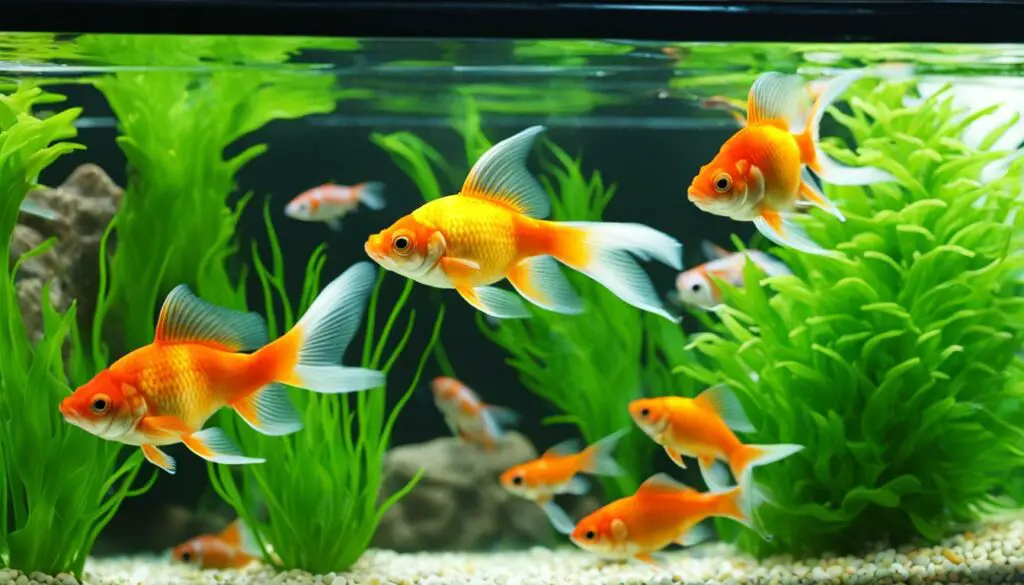
There is a common misconception that goldfish can thrive in small bowls. However, this is far from the truth. Goldfish require a suitable tank with proper filtration, aeration, and sufficient water volume for waste dilution. Keeping a goldfish in a bowl can lead to a number of problems and negatively impact its health and well-being.
Goldfish produce a significant amount of waste, and bowls do not provide adequate space for waste dilution. This can lead to poor water quality, which in turn can result in various health issues for the goldfish. Additionally, goldfish are messy eaters, and the lack of space in a bowl can cause uneaten food to accumulate, further compromising water quality.
The “common goldfish,” in particular, can grow quite large and requires ample swimming space. It is best suited for an outdoor pond or a large aquarium. Keeping a goldfish in a small bowl would restrict its growth and hinder its natural behavior.
Why goldfish bowls are not suitable:
- Bowls do not provide sufficient space for goldfish to swim and exercise, which can lead to stunted growth and a weakened immune system.
- Bowls lack proper filtration systems, leading to poor water quality and an increased risk of diseases.
- The limited water volume in a bowl makes it challenging to maintain stable water parameters, such as temperature and pH, which are crucial for the health of goldfish.
- Bowls do not allow for the installation of an adequate aeration system, which can lead to low oxygen levels in the water, causing stress and compromising the goldfish’s overall well-being.
Providing a suitable habitat for goldfish is essential for their overall health and happiness. To ensure their well-being, it is recommended to provide them with a spacious tank or pond that meets their specific needs. The tank should be equipped with a proper filtration system, appropriate aeration, and regular water testing and maintenance.
Goldfish Bowl vs. Suitable Tank
| Goldfish Bowl | Suitable Tank |
|---|---|
| Limited swimming space | Plenty of space for exercise and natural behavior |
| Poor water quality due to lack of filtration | Effective filtration system to maintain water quality |
| Challenging to maintain stable water parameters | Controlled environment with stable temperature and pH |
| Inadequate aeration | Proper aeration to ensure oxygen-rich water |
As responsible pet owners, it is our duty to provide the best possible care for our goldfish. Let’s debunk the goldfish bowl myth and create a proper habitat that allows these beautiful creatures to thrive.
Myth: Goldfish Only Grow to the Size of Their Enclosure
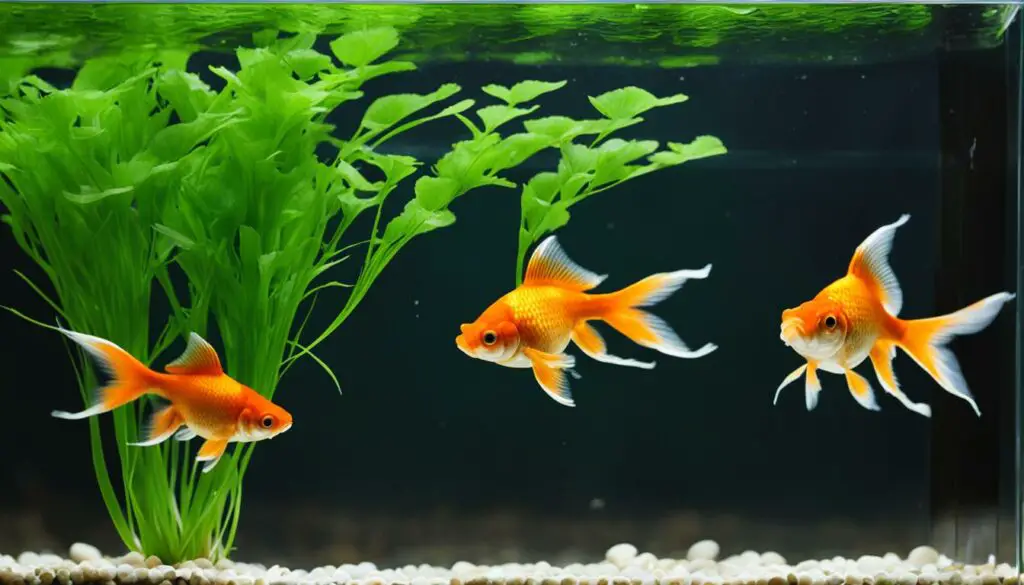
The growth of goldfish is primarily determined by water quality and not the size of their enclosure. While it is a common belief that goldfish will only grow to the size of their tank, this is a misconception. Poor water quality associated with a small tank can actually stunt the growth of goldfish, leading to stunted goldfish growth.
When properly cared for, goldfish have the potential to grow to their full size. The size that goldfish can reach is dependent on factors such as genetics, diet, and overall health. Some species of goldfish, like the “common goldfish,” can reach impressive sizes of up to 45cm in length. This remarkable growth requires a tank of suitable size to accommodate their needs.
To ensure proper goldfish growth, it is essential to provide them with a spacious environment that allows for free swimming. A congested or undersized tank can restrict their movement and impact their overall well-being. Additionally, a larger tank provides more water volume, which helps maintain optimal water quality for the goldfish.
By providing a well-maintained tank with appropriate filtration, regular water changes, and a nutritious diet, goldfish can thrive and reach their full potential. Avoiding overcrowding and ensuring adequate space for each goldfish is crucial. Remember, a larger tank not only benefits their growth but also promotes a healthier and happier life for these beautiful aquatic pets.
Myth: Goldfish Don’t Live Long
Contrary to a common misconception, goldfish can actually live for several decades when provided with proper care and a suitable environment. The myth that goldfish have a short lifespan stems from the many premature deaths attributed to inappropriate living conditions, such as small tanks or poor water quality.
Goldfish have the potential to live a long and healthy life when their needs are met. By understanding their requirements and taking the necessary precautions, goldfish owners can ensure the longevity of their beloved aquatic pets.
Here are some key factors that contribute to the lifespan of goldfish:
- Size of the tank: A larger tank provides ample swimming space and better water quality, which are essential for goldfish health and well-being. A cramped environment can impede their growth and reduce their lifespan.
- Water quality: Goldfish are sensitive to poor water conditions, including high levels of ammonia and nitrite. Regular water changes, proper filtration, and testing water parameters help maintain a clean and healthy environment for goldfish.
- Nutrition: A balanced and nutritious diet is crucial for goldfish. Feeding them high-quality food and avoiding overfeeding can promote their overall health and prevent potential health issues that may shorten their lifespan.
- Age and genetics: Like any living organism, the genetics and age of goldfish can influence their lifespan. Some goldfish breeds, such as the common goldfish, have the potential to live longer than others.
- Avoiding stress: Stress can weaken a goldfish’s immune system and make them more susceptible to diseases. It is important to provide a stress-free environment, avoiding sudden changes in temperature, overcrowding, and aggressive tankmates.
With proper care and attention to these factors, goldfish can thrive and live well beyond the commonly believed myth of a short lifespan.
Goldfish lifespan can extend for several decades with proper care and a suitable environment.
“Contrary to common belief, goldfish can live for several decades when provided with suitable living conditions.”
Conclusion
Goldfish are fascinating creatures that require proper care and attention to thrive in a home aquarium. While they are generally not aggressive towards other fish, it is important to understand their feeding habits to ensure a harmonious tank environment.
Contrary to popular belief, goldfish may eat smaller fish or their own babies when hungry. To prevent cannibalism, it is essential to provide sufficient food and space for goldfish. Regular feeding and a well-balanced diet are crucial for their overall health and well-being.
When considering tankmates for goldfish, it is important to carefully choose compatible fish and invertebrates. Pay attention to the size and temperament of potential tankmates to prevent any aggressive behavior or undue stress. Snails can be great companions for goldfish, while shrimp are not recommended due to their small size.
To ensure the longevity of goldfish, proper care, nutrition, and water quality are paramount. Regular monitoring of water parameters, timely removal of any dead fish, and maintaining a suitable tank environment are essential for their thriving. Providing a spacious tank with plenty of hiding places and a suitable filtration system is crucial to their overall well-being.
FAQ
Do Goldfish Eat Other Fish?
Goldfish are generally not aggressive or predatory towards other fish. However, when goldfish are hungry and left without food, they may eat bite-sized fish or baby goldfish to survive. While they may eat their own babies, once the baby fish are larger and able to swim, the predation drops significantly. Goldfish may also accidentally consume small fish or snails in the same tank while searching for food. It is important to consider the size of tank mates when keeping goldfish with other fish or invertebrates.
Do Goldfish Eat Other Goldfish?
Goldfish may eat their own babies when they are hungry. They do not exhibit paternal instincts and may mistake baby goldfish for food. Some baby goldfish may also fall prey to larger goldfish or other predators in the tank. However, as the baby fish grow and become more independent, the risk of predation decreases.
Why Do Goldfish Eat Other Fish?
Goldfish may eat larger fish in certain circumstances, particularly when they feel their territory is being invaded or overcrowded. When a tank is too crowded with other fish, goldfish may become aggressive and territorial, leading them to attack or eat larger fish. It is important to provide sufficient space and avoid overcrowding in the tank to prevent this behavior.
Does a Goldfish Eat Dead Fish?
Goldfish may eat dead fish in the tank as a way to remove the carcass and alleviate their hunger. It is important to promptly remove any dead fish from the tank to prevent goldfish from consuming them. Goldfish have a scavenging behavior and may eat anything they come across, including dead fish.
Which Fish Are Safe With a Goldfish?
Goldfish are compatible with certain species of fish and invertebrates. They generally coexist well with snails, as long as the snails are not smaller than the goldfish. However, goldfish may accidentally or deliberately eat tiny snails or their eggs. It is not recommended to keep shrimp with goldfish, as shrimp are small and can easily fit in the goldfish’s mouth.
What to Consider When Keeping Goldfish Together?
When keeping goldfish together, it is important to consider several factors. All the goldfish in the tank should be of similar size to avoid larger fish preying on smaller ones. Sufficient space should be provided for each fish to prevent overcrowding and to allow them to swim freely. A larger tank is recommended for goldfish due to their fast growth and high waste production. Rocks and plants should also be included in the tank to provide hiding places and create a safe environment.
Is It True That Goldfish Have a Three-Second Memory?
The myth that goldfish have a three-second memory is widely believed. However, goldfish can actually hold memories for up to five months and have a sense of time and routine. They can recognize their owners and show excitement when they see them. This myth has led to the misconception that goldfish can be kept in small bowls, when in reality they require proper care and a suitable environment.
Can Goldfish Be Kept in Bowls?
Contrary to popular belief, goldfish cannot thrive in small bowls. They produce a lot of waste, are messy eaters, and require a tank with proper filtration, aeration, and sufficient water volume for waste dilution. The “common goldfish” can grow particularly large and is best suited for an outdoor pond or a large aquarium. A bowl is not a suitable home for goldfish.
Do Goldfish Only Grow to the Size of Their Enclosure?
The growth of goldfish is primarily determined by water quality and not the size of their enclosure. Poor water quality, associated with a small tank, can stunt the growth of goldfish. When properly cared for, goldfish can grow to their full size. The “common goldfish” can reach up to 45cm in length and requires a tank of suitable size to accommodate its growth.
Do Goldfish Live Long?
Goldfish can actually live for several decades when well cared for. Premature deaths of goldfish are often the result of inappropriate living conditions, such as small tanks or poor water quality. With proper care and a suitable environment, goldfish can live a long and healthy life.
Source Links
- https://www.hepper.com/do-goldfish-eat-each-other-or-other-fish/
- https://i.stuff.co.nz/life-style/homed/104604108/common-goldfish-myths-debunked
- https://aquariumscience.org/index.php/1-2-falsehoods-and-myths/

